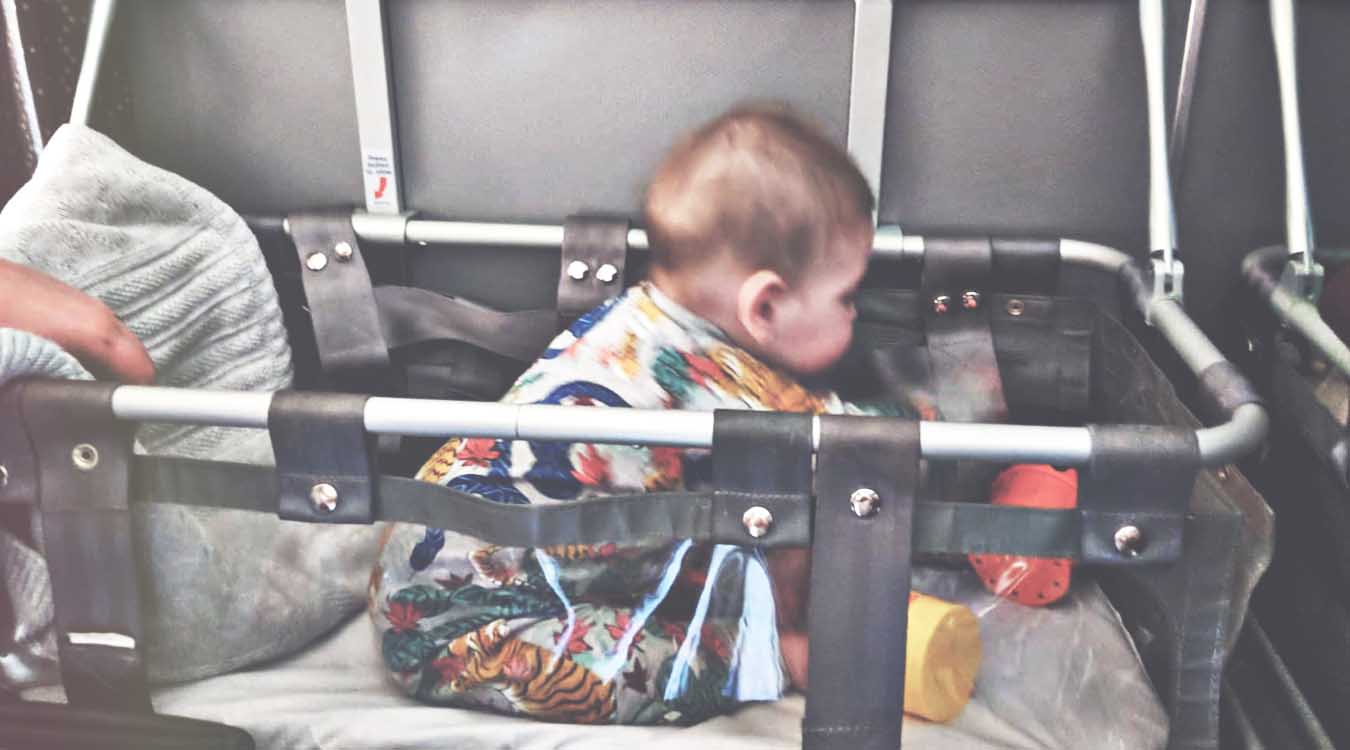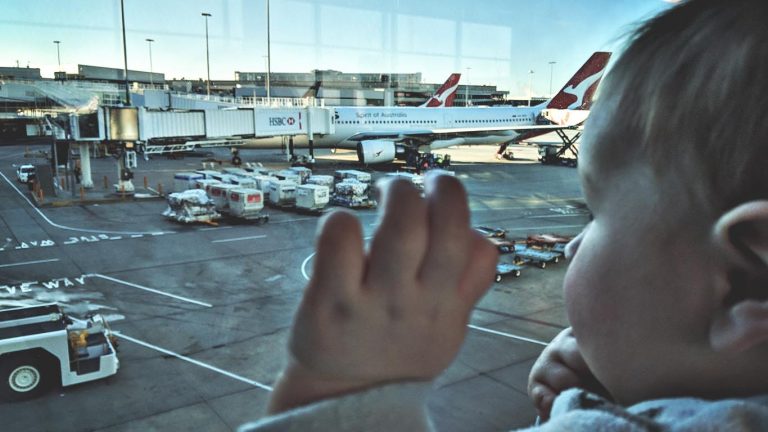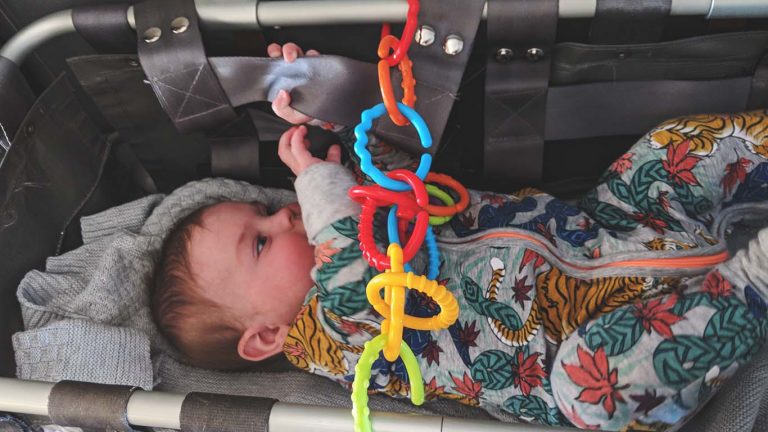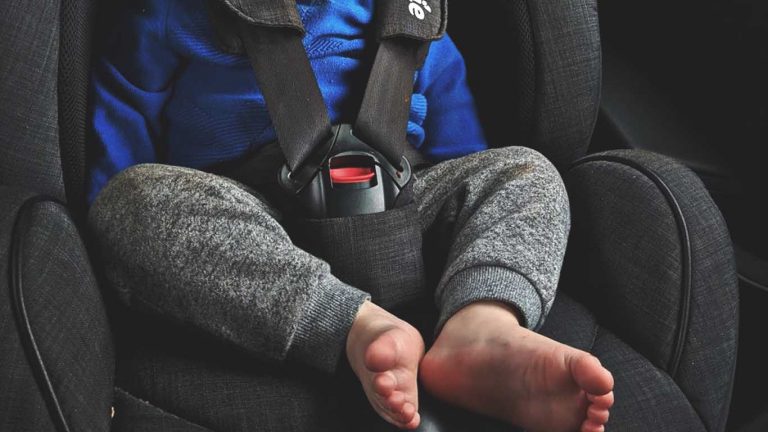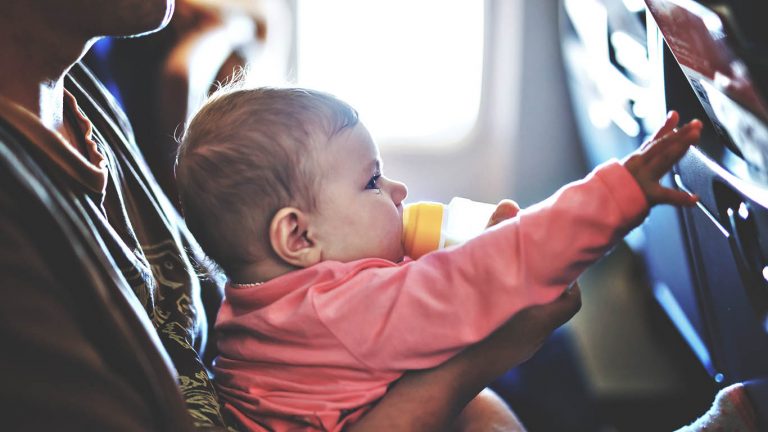If the thought of a screaming baby in a small space with the critical gaze of fellow passengers is putting you off your next adventure, a collapsible airplane bassinet could make the journey easier. With an airplane bassinet your little one might nap mid-flight, and you could have your arms free.
Most airlines will offer a free or discounted fare to children under two, but there is a catch. When traveling by plane your “free” miniature passenger will be confined to your lap. This is probably achievable for short trips, but what about those long haul, international flights?
In the following guide we will answer all your questions about airplane bassinets including how to book, any safety concerns, and tips for settling your baby while in the air.
What is an airplane bassinet?
An airplane bassinet, or sky cot, is an attachable bed for your baby. Generally speaking (as all flights you take might differ) the bassinet is a cot that is attached to the wall in the bulkhead area, spanning across two seats (in economy).
Most airlines only have it available with seats in the bulkhead section of the plane. These are the seats often near the galley or toilets, and often come with extra leg room so they can get snapped up quickly.
When the airplane bassinet is secured to the wall it creates a safe space for your baby to rest. It is usually installed once you are in the air. If you haven’t set it up before, most are pretty easy, but the crew will be more than happy to assist.
The average size is 28 inches x 12 inches with some variations depending on who you fly with. You cannot take your own bassinet on board.
While less common, some aircrafts will have built in airplane bassinets which you will find in the seat compartments.
Most airlines will have weight, height, or length limits…
It is important to note that every airline is different. Even the size, weight, and age restrictions may vary, and you should always double check prior to booking.
Just like your bassinet at home, some sky cots will only have a very thin restraint, making them more suitable for bubs who can’t sit themselves up yet. This is usually under 6 months old.
However, other airlines cater to children up to 2, assuming they can still fit inside. While there is not one rule across the board, it is fairly common to have a maximum weight limit somewhere between 20 and 25lbs.
Most of the time airplane bassinets will not be available on domestic flights, but there are exceptions to this rule.
When to put your baby on your lap…
For safety reasons airplane bassinets cannot be used during certain times and parents will need to hold their baby on their lap, secured with the special infant seatbelt supplied by the airline.
Most airlines enforce that each infant must have their own adult (usually over 16) to accompany them. This means no traveling solo with twins! For example, Etihad Airlines enforce this policy and insist the guardian arranges another adult for each additional child. Qantas only allows additional infants if they can sit upright or have a carseat, and you cannot book online.
There may be limited airplane bassinets on board…
As a parent you will already know the key to your sanity is being organized. Even a “spontaneous” trip away will still require planning, packing, and thought. If you think you may need an airplane bassinet it should be at the top of your list when booking your fare. Quantities will be limited, and they may be assigned by age…or to whoever gets in first!
Most of the time they will be free to use but occasionally you may encounter an additional small fee. Keep reading because we will give you a few more tips on how to secure an airplane bassinet later in the article.
Tips for using an airplane bassinet
If you have managed to score access to a bulkhead seat there are a few things you should consider. An airplane can be a germ factory and other kids have used the bassinet before yours.
For your own peace of mind, you can give it a quick wipe down before use. You may also like to check it for any rips or stability issues.
There’s no place like home…
Initially it may be hard to settle your baby in the bassinet. Using a few strategies from your usual bedtime routine could make a difference.
You may be loaned a bassinet liner and bedding, but if your baby has a special blanket that they are attached to it will make the transition easier. Often something which “smells like home” will be a life saver.
Does your child use a pacifier or a bottle? Not only will these items offer comfort, but they may also help to combat sore or blocked ears which are commonly caused by air pressure.
Turn down the lights…
To avoid your baby becoming overstimulated you could try using a bassinet cover. There is nothing worse than an overtired child, and it can be difficult to calm them down once they reach a certain point. With unusual noises, new faces, and bright lights even the comfort of a cozy bed might not be enough to send them off to dreamland.
A “one size fits all” stroller cover will block out most of the distractions and hopefully lead to a more peaceful sleep. Mom or Dad may even be able to sneak in a nap!
40,000 feet in the air is probably not the best place to practice the cry it out method, and your baby could still need the comfort of a hug. If they are having trouble settling in the airplane bassinet you could offer them some cuddles…and try again later.
In the weeks prior to your holiday you may like to encourage your baby to self settle and experience sleeping in different environments. For example, you can get them used to the stroller cover by taking them for walks in a noisy shopping centre.
Are airplane bassinets safe to use?
The safest way to travel with a baby is with an FAA approved car seat. Yes, even on a plane. To do this you would need to purchase an additional ticket for your little one and take a car seat with you. This option will keep them in place during take off, turbulence, and landing, even if you do opt for an airplane bassinet.
However, a car seat isn’t a legal requirement and can be an extra piece of luggage for you to carry around. Some airlines might not even let you book an individual seat for a child who is under the age of two.
An undamaged airplane bassinet is an appropriate choice and will be safe when used correctly.
On the odd occasion you might find an airline with an airplane bassinet which is placed on the floor. This is not recommended as it could pose as a safety risk, particularly during unexpected turbulence or in the case of an emergency.
Creating a safe sleeping space…
When it comes to baby bedtime experts recommend a safe sleeping space, regardless of whether you are at home, in transit, or at a hotel. To make your airplane bassinet safe for baby you might consider:
- Avoiding the use of any toys or potential choking hazards
- Placing your child on their back
- Swaddling your baby only if it is age appropriate
- Avoiding the use of pillows
- Being conscious of blankets (you might opt for an infant sleeping bag)
Having their feet facing the aisle is the policy of most airlines. This is a good point to remember as you don’t want to wake a sleeping baby just to turn them around.
How do you book an airplane bassinet?
Booking an airplane bassinet should be done early to avoid disappointment. Not only will you need to ensure there is a baby bed available, but you will have to be seated in a specific area. With some first class or business class fares there may be a different style airplane bassinet available. Or, they may have none at all.
If your baby does not fit within the size and weight guidelines when you are preparing to board your flight, they may be refused the cot. This could cause a disruption to your plans so you may like to weigh them to ensure you won’t need a back up plan.
Regardless of whether you are booking your tickets online or over the phone, it is suggested you always confirm the information directly with the airline. For those who are booking through a travel agent they should be able to organize this for you.
However, you might still like to check yourself, just to be sure! It is recommended you phone again in the days prior to your trip, as well as confirming at the airport. If there has been an oversight it is better to give the airline time to rectify it.
There is no standard for airline bassinet policies…
To make a tricky subject even trickier, we have to reinforce the point that policies can vary between countries, airlines, and even specific flights!
Our advice is to always contact each carrier you intend to fly with as they may change their policies from time to time. This means for longer trips you may be using multiple airlines and you may like to enquire with each one.
A few examples of airline policies…
To give you an idea of what you should expect in regard to using an airplane bassinet, we have researched the policies of 6 popular airlines*:
#1. Air France passengers will be met with a maximum weight limit of 22lbs, and a maximum length of 27 inches for their airplane bassinets. They are available on selected flights and there is only a limited quantity. To book you will need to call at least 48 hours before your flight.
#2. Air New Zealand have airplane bassinets available on some of their international flights. They are suitable for a baby up to 8 months old with a weight limit of 26lbs. Depending on availability, you may still be able to request a baby bassinet if your child weighs under the limit and is under 15 months of age. You can choose a bassinet seat when you book online but they suggest that you still call to confirm.
#3. American Airlines do have a limited number of airplane bassinets available on selected flights. They suggest arriving to the airport early on the day of your departure as priority will be given to those who ask first! Infants need to be under 2 years of age and have a weight of less than 20lbs.
#4. Emirates has an age limit of 2 years old, but your little one should be under 24.2lbs. You can request a baby bassinet when booking online, or by calling customer service. As a bonus, on some flights you will find a change table and receive a goodie bag with bibs, diapers, and other necessities.
#5. Malaysian Airlines advise calling at least 24 hours prior to your flight to secure an airplane bassinet. They can be used for children under 2. Their sky cots are only available on specific aircrafts and there are limited quantities.
#6. Qantas has two types of airplane bassinets available. For select domestic flights there is a maximum age limit of 6 months, and for international flights there is a maximum age of 18 months. Once again, the age limit will depend on the size of your baby and whether they can fit safely inside. You will need to contact the airline directly to book.
The Wrap Up…
Flying with a baby will be made easier if you book an airplane bassinet. For long flights they will be more likely to sleep when they are in a comfortable space. When they have a familiar object such as their favorite blanket and a cover to block the light, your baby will feel safe and secure.
If you are considering an airplane bassinet for your next flight, booking in advance is essential. While sometimes you can do this online, most of the time ringing directly is the best option. Not all airlines will be able to accommodate your request and there are limited quantities available.
Just because your baby is under 2 and has a free ticket, it doesn’t necessarily mean they will be able to fit in an airplane bassinet. Policies vary and we suggest checking the weight and length limit of the specific airline you are traveling with.
Add an airplane bassinet to your checklist of things to organize, and even if you don’t use it – at least the option will be there!
Have you accessed an airplane bassinet on a domestic or international flight? What was your experience? We would love to hear from you, please let us know your thoughts in the comments section below.
*Information is correct at the time of publication but may be subject to change. Please check with your airline for the most current advice.
